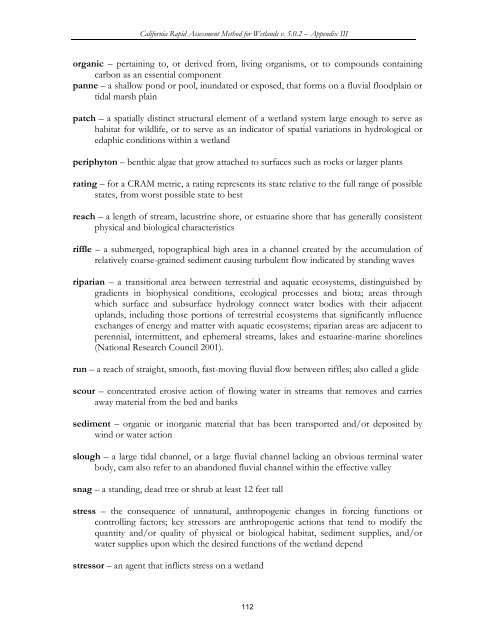(CRAM) For Wetlands User's Manual Version 5.0.2
(CRAM) For Wetlands User's Manual Version 5.0.2
(CRAM) For Wetlands User's Manual Version 5.0.2
You also want an ePaper? Increase the reach of your titles
YUMPU automatically turns print PDFs into web optimized ePapers that Google loves.
California Rapid Assessment Method for <strong>Wetlands</strong> v. <strong>5.0.2</strong> – Appendix III<br />
organic – pertaining to, or derived from, living organisms, or to compounds containing<br />
carbon as an essential component<br />
panne – a shallow pond or pool, inundated or exposed, that forms on a fluvial floodplain or<br />
tidal marsh plain<br />
patch – a spatially distinct structural element of a wetland system large enough to serve as<br />
habitat for wildlife, or to serve as an indicator of spatial variations in hydrological or<br />
edaphic conditions within a wetland<br />
periphyton – benthic algae that grow attached to surfaces such as rocks or larger plants<br />
rating – for a <strong>CRAM</strong> metric, a rating represents its state relative to the full range of possible<br />
states, from worst possible state to best<br />
reach – a length of stream, lacustrine shore, or estuarine shore that has generally consistent<br />
physical and biological characteristics<br />
riffle – a submerged, topographical high area in a channel created by the accumulation of<br />
relatively coarse-grained sediment causing turbulent flow indicated by standing waves<br />
riparian – a transitional area between terrestrial and aquatic ecosystems, distinguished by<br />
gradients in biophysical conditions, ecological processes and biota; areas through<br />
which surface and subsurface hydrology connect water bodies with their adjacent<br />
uplands, including those portions of terrestrial ecosystems that significantly influence<br />
exchanges of energy and matter with aquatic ecosystems; riparian areas are adjacent to<br />
perennial, intermittent, and ephemeral streams, lakes and estuarine-marine shorelines<br />
(National Research Council 2001).<br />
run – a reach of straight, smooth, fast-moving fluvial flow between riffles; also called a glide<br />
scour – concentrated erosive action of flowing water in streams that removes and carries<br />
away material from the bed and banks<br />
sediment – organic or inorganic material that has been transported and/or deposited by<br />
wind or water action<br />
slough – a large tidal channel, or a large fluvial channel lacking an obvious terminal water<br />
body, cam also refer to an abandoned fluvial channel within the effective valley<br />
snag – a standing, dead tree or shrub at least 12 feet tall<br />
stress – the consequence of unnatural, anthropogenic changes in forcing functions or<br />
controlling factors; key stressors are anthropogenic actions that tend to modify the<br />
quantity and/or quality of physical or biological habitat, sediment supplies, and/or<br />
water supplies upon which the desired functions of the wetland depend<br />
stressor – an agent that inflicts stress on a wetland<br />
112















